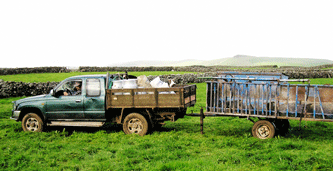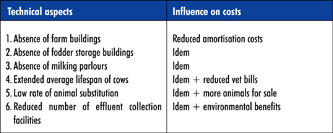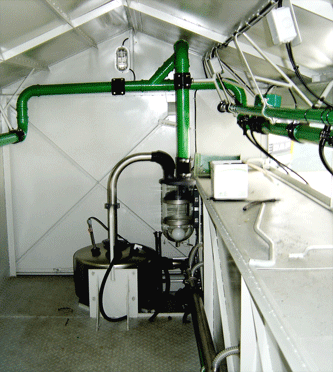 COUNTRY OF ORIGIN
COUNTRY OF ORIGINGrazing dairy cows, a model of sustainable agriculture
Grazing dairy cattle in practice
Grazing dairy cattle farming in the Azores preserves the environment and supplies consumers with healthy, high quality organoleptic products. It is profitable for producers, guarantees good prices for consumers, motivates the young generation to continue farming and contributes to a balanced development of other sectors. The milk production system has the following characteristics:
In the Azores Autonomous Region, vocational training is a fundamental instrument used to help young farmers set up agricultural enterprises.
The Azores account for 2.5% of the Portuguese territory, but in terms of production they provide about 30% of Portugal’s total milk production.
In the last few years producers in the Azores have bought milk production quotas (the European Union has a production quota regime) from farmers on mainland Portugal. So despite the cost of shipping local products to Lisbon and other cities in Portugal, the milk production method in the Azores continues to be competitive in a saturated market such as Europe’s.
Economies of scale
There are also other economies of scale:
[list]Rotation or perennial pasture means reduced costs because there is little need for tillage, sowing, fertilising, harvesting and food storage;
[list]In a favourable climate, with a good rainfall, spread throughout the year, as in the Azores, there is little need for irrigation or fertilisation, since nutrients present in cow dung helps to fertilise the soil.
Sustainable territorial management
The islands of the Azores, which are all of volcanic origin, are characterised by steep hills and friable land. The presence of stone walls on the grazing land, the fact that the soil is rarely ploughed, and careful crop rotation all help prevent the flowing of surface water and consequent land slips.
The same intensive management system also preserves environmental quality: the land is not overexploited and there is little need to use fertilisers, since cow dung meets most fertilisation needs; this prevents soil salinization, a phenomenon which is frequent in intensive pasture areas. Careful pasture management also guarantees weed control, so that there is little need for herbicides. This means that there is no danger of polluting water layers, a very serious problem in areas that make excessive use of Atrazine.
Animal health
Non-intensive milk production leads to improved animal health. Cows that produce 15-20 litres of milk a day are far less prone to the so-called technopathologies of industrially farmed animals: mastitis, foot disease, changes in ovulation cycles, metabolic disorders, all problems which require constant veterinary attention and massive use of pharmaceutical products.
The results produced by semi-intensive management go beyond reduced farming costs: they can be seen in improved animal health and an increase in the average lifespan of cows from 5-6 years to 10-12 years.
Milk quality and public health
The fact that this production process does not involve chemical products means that there is little difficulty in obtaining a ”biological” certificate. Carefully washing of all milking equipment and rapid refrigeration is all that is needed to obtain a final product with microbiological parameters that give it the status of “high-quality milk”.
The produce of this type of semi-intensive management, in contrast to industrially produced milk, has the typical organoleptic qualities that give it a taste and smell that denotes quality, and makes it particularly safe for consumption by children, the sick and elderly.
It is, in every respect, a very advanced dairy cattle management system that can offer competitively priced, high quality produce. Because it is easy to set up and replicate, and requires little economic investment, this type of pasture management can be easily applied, completely or in part, in any country where there is dairy cattle.
Soft technology
The model used in the Azores makes use of what is known as soft technology:
[list]Electric wire to fence off pasture areas;
[list]Fodder rolled in plastic bags which are kept on the pastureland;
[list]Mobile milking machines.
Mobile milking machines
The mobile milking machines are the most interesting innovation in the management of dairy cattle in the Azores: from the simplest of machines, with two milking points, to the most complex with 10 or 12 milking points; they were introduced more than 30 years ago.
Built in the Azores by assembling various components, they are very efficient and practical to use; they are also cheap to build, and represent the backbone of this production model.
A mobile milking machine consists of a chassis and two wheels, with a system to hook it onto a tractor or any other traction vehicle; it can even be pulled by horses. A motor on top of the chassis produces a vacuum, and there are tubes and everything else that can be found in a milking parlour.
One side is made up of various racks with troughs where the heads of the cows are locked into place, so that they can be fed silage or small quantities of concentrate while they are being milked.
The milk is pumped into a wheeled tank, or a tank located on another vehicle. These tanks can be refrigerated, which helps to improve the microbiological quality of the milk.
Mobile milking machine mean that cows can be milked directly on the pastureland, which greatly facilitates operations for farms whose land is divided into lots located in different areas.
DOWNLOAD THE BROCHURE PDF
English (0.8 MB)Spanish (0.8 MB)
Portuguese (0.8 MB)
ONLY TEXT
•Grazing dairy cattle in practice







